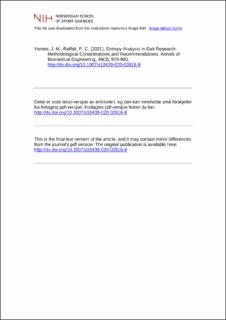| dc.contributor.author | Yentes, Jennifer M. | |
| dc.contributor.author | Raffalt, Peter Christian | |
| dc.date.accessioned | 2022-03-04T08:54:22Z | |
| dc.date.available | 2022-03-04T08:54:22Z | |
| dc.date.created | 2021-06-09T18:40:44Z | |
| dc.date.issued | 2021 | |
| dc.identifier.citation | Annals of Biomedical Engineering. 2021, 49(3), 979-990. | en_US |
| dc.identifier.issn | 0090-6964 | |
| dc.identifier.uri | https://hdl.handle.net/11250/2983001 | |
| dc.description | I Brage finner du siste tekst-versjon av artikkelen, og den kan inneholde ubetydelige forskjeller fra forlagets pdf-versjon. Forlagets pdf-versjon finner du på link.springer.com / In Brage you'll find the final text version of the article, and it may contain insignificant differences from the journal's pdf version. The original publication is available at link.springer.com | en_US |
| dc.description.abstract | The usage of entropy analysis in gait research has grown considerably the last two decades. The present paper reviews the application of different entropy analyses in gait research and provides recommendations for future studies. While single-scale entropy analysis such as approximate and sample entropy can be used to quantify regularity/predictability/probability, they do not capture the structural richness and component entanglement characterized by a complex system operating across multiple spatial and temporal scales. Thus, for quantification of complexity, either multiscale entropy or refined composite multiscale entropy is recommended. For both single- and multiscale-scale entropy analyses, care should be made when selecting the input parameters of tolerance window r, vector length m, time series length N and number of scales. This selection should be based on the proposed research question and the type of data collected and not copied from previous studies. Parameter consistency should be investigated and published along with the main results to ensure transparency and enable comparisons between studies. Furthermore, since the interpretation of the absolute size of both single- and multiscale entropy analyses outcomes is not straightforward, comparisons should always be made with a control condition or group. | en_US |
| dc.language.iso | eng | en_US |
| dc.subject | regularity | en_US |
| dc.subject | complexity | en_US |
| dc.subject | single-scale | en_US |
| dc.subject | walking dynamics | en_US |
| dc.title | Entropy Analysis in Gait Research: Methodological Considerations and Recommendations | en_US |
| dc.type | Peer reviewed | en_US |
| dc.type | Journal article | en_US |
| dc.description.version | acceptedVersion | en_US |
| dc.source.pagenumber | 979-990 | en_US |
| dc.source.volume | 49 | en_US |
| dc.source.journal | Annals of Biomedical Engineering | en_US |
| dc.source.issue | 3 | en_US |
| dc.identifier.doi | 10.1007/s10439-020-02616-8 | |
| dc.identifier.cristin | 1914914 | |
| dc.description.localcode | Institutt for fysisk prestasjonsevne / Department of Physical Performance | en_US |
| cristin.ispublished | true | |
| cristin.fulltext | postprint | |
| cristin.qualitycode | 1 | |
